The Beauty of the Invisible: Unterschied zwischen den Versionen
Keine Bearbeitungszusammenfassung |
Keine Bearbeitungszusammenfassung |
||
| Zeile 27: | Zeile 27: | ||
<br style="clear:both;" /> | <br style="clear:both;" /> | ||
[[Datei:Perlage.jpg|thumb|Perlage]] | [[Datei:Perlage.jpg|thumb|Perlage]] | ||
=== | === The perlage === | ||
The perlage consists of small, overlapping circles, achieved with a rotating grinding tip. In A. Lange & Söhne watches, it is mainly used for bridges and plates. | |||
<br style="clear:both;" /> | <br style="clear:both;" /> | ||
[[Datei:Flachpolitur.jpg|thumb|Flachpolitur]] | [[Datei:Flachpolitur.jpg|thumb|Flachpolitur]] | ||
Version vom 4. August 2011, 01:31 Uhr
The Beauty of the Invisible
Traditional finish techniques at A. Lange & Söhne
A. Lange & Söhne timepieces of the 21st century constitute the link to a heritage that began in Saxony more than 165 years ago. From the very beginning, Ferdinand A. Lange described his business philosophy as follows: “With the knowledge that quality craftsmanship always assures the most advantageous purchase, we are aware that we can render the best service to our clientele by supplying only watches of the highest class.” Lange still upholds this commitment to the ethics of the artisan, because this alone creates a little piece of eternity in an ever changing world.
Indeed, A. Lange & Söhne timepieces still feature quality hallmarks that were once the norm in high-end watchmaking, but which were gradually abandoned in favour of costeffectiveness in production. Among the typical hallmarks are the surface finishes applied to nearly all movement parts. For the owner of such a piece of art, the composition of aesthetic details is matched by the mechanical precision of the movement. Every single one of them illustrates the manufactory’s uncompromising quest for perfection.
Here is an overview of the most important finish techniques:
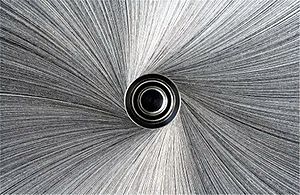
The sunray finish
The sunray finish is mainly used on bigger wheels and parts of the framework. The graining results in a spirally pattern.
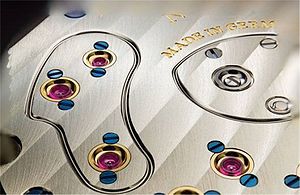
The Glashütte ribbing
The Glashütte ribbing emulates a gently rippled effect. The pattern decorates the three-quarter plate and some other large parts of the framework.
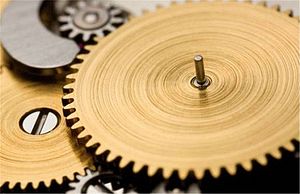
The circular graining
Circular graining is used on round shapes such as wheels. Unlike most other finishes, this one is applied by rotating the part around the tool.
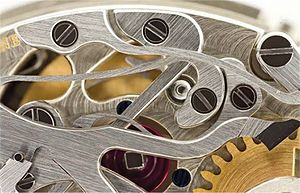
The linear finish
The fine lines in a parallel direction are achieved by sliding a part in one direction over a piece of abrasive paper.
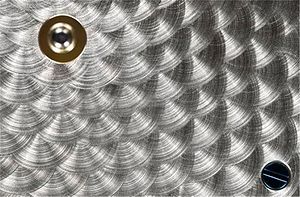
The perlage
The perlage consists of small, overlapping circles, achieved with a rotating grinding tip. In A. Lange & Söhne watches, it is mainly used for bridges and plates.
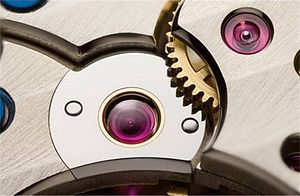
Die Flachpolitur
Bei der Flachpolitur entsteht durch das behutsame Reiben eines Werkteils auf extrem feinkörnigen Diamantfolien in achtförmigen Bewegungen eine spiegelglatte Oberfläche.
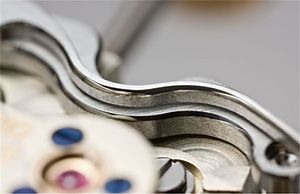
Die Fasenpolitur
Bei der Fasenpolitur werden die auf exakt 45 Grad angeschrägten Kanten der Werkteile von Hand poliert. Eine besondere Herausforderung stellen die spitzen Winkel der innen liegenden Ecken dar.

Der Umfangschliff
Beim Umfangschliff erhalten die Konturen der Gestellteile eine matte Oberfläche, die einen lebendigen Wechsel zu den polierten Fasen schafft.
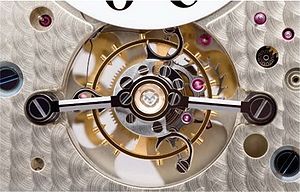
Die Schwarzpolitur
Die Schwarzpolitur ist die anspruchsvollste und zeitintensivste Art der Finissierung. Sie wird nur der Tourbillonbrücke und dem Käfigoberteil zuteil. Die Politur eines einzigen Teils kann bis zu fünf Tage in Anspruch nehmen.
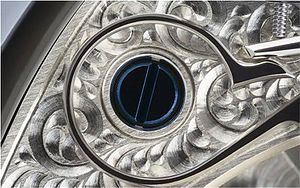
Die Gravur
Die Gravur lässt jeden Zeitmesser von A. Lange & Söhne zum Unikat werden: Jeder Unruhkloben wird von einem von sechs Meistergraveuren im freien Schnitt mit einem floralen Muster verziert.